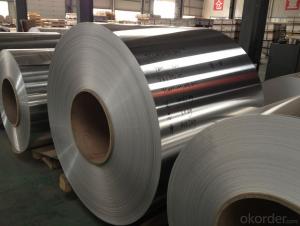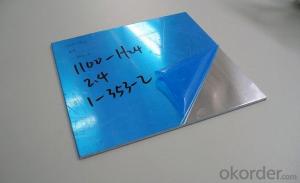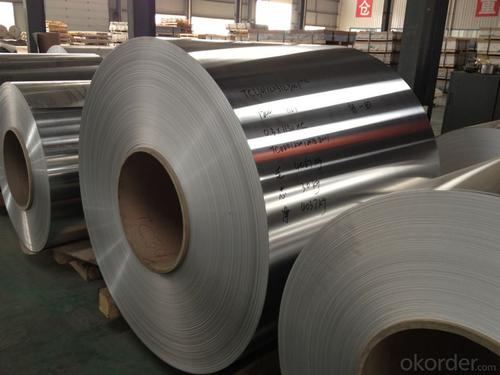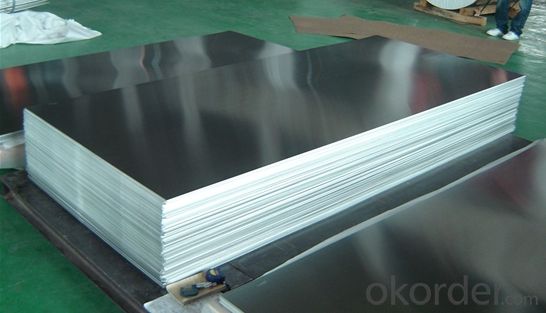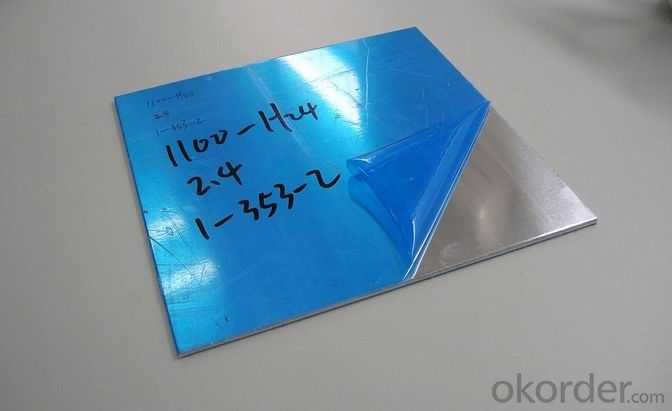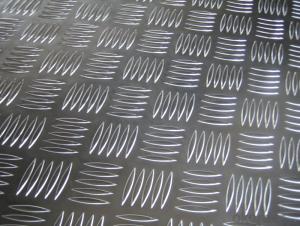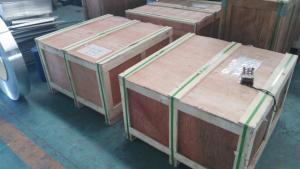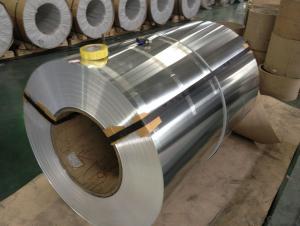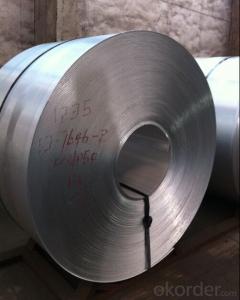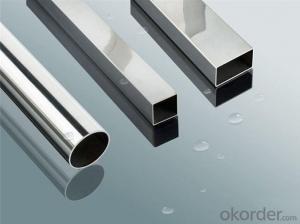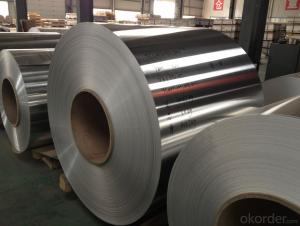Copper Colored Aluminum Sheets - Aluminium Cold Drawn Aluminum Slab Stocks in Warehouse
- Loading Port:
- Shanghai
- Payment Terms:
- TT OR LC
- Min Order Qty:
- 2 m.t
- Supply Capability:
- 6000 m.t/month
OKorder Service Pledge
OKorder Financial Service
You Might Also Like
Specification
1.Structure of Product Description
Cold rolled aluminum sheet is widely used in the field of construction field and decoration field, etc.
There are many different grades, such as: 1000 series, 2000 series,
8000 series5000 series, 7000series,etc. The detailed grade are as follows: 1010, 1050,1060,1100, 2024, 3003, 3005, 3105, 5052,5754,5083,6061,6063,8011, etc.
The temper is include H14, H22, H24, H44,H112, etc.
2. Main features of the product
a.Competitive price
b.Frist-Class Service.
3. Image.
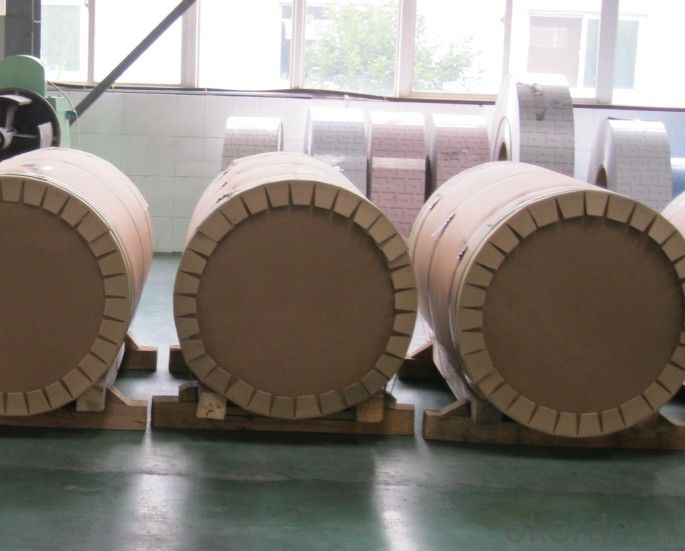
4.Product detailed sizes:
1000mm*2000mm, 1219mm*2438mm,100mm*3000mm, etc.
5. FAQ:
What is the quality standard?
---Usually our standard is GB3880-2006 or others.
What is the width range?
---It is from 150MM to 2000mm, etc.
What is the length range:
---It is from 600mm to 6000mm, etc.
What is the MOQ for your products yet?
---Normally it is around 7tons/each size.
How many tons did you export in one year?
---Normally it is around 600 tons totally.
Where is your client from?
---Normally it is from Fiji,Turkey, UAE, Saudi Arabia, Japan, USA, England,Canada,etc.
What is your mainly products?
---Normally they are cold rolled and hot rolled and cold drawn aluminum sheet,small-5-bar checkered sheet,big-5-bar checkered cold rolled aluminum sheet, mirror finish aluminium sheet,aluminum sandwich panel, aluminum composite panel,etc.
- Q: What are the special coatings or treatments available for enhancing the properties of aluminum sheets?
- <p>Yes, there are several special coatings and treatments that can be applied to aluminum sheets to enhance their properties. These include anodizing, which creates a protective oxide layer, powder coating for a durable and colorful finish, and thermal spraying for improved wear resistance. Other treatments involve chemical conversion coatings, such as chromate conversion, which provides corrosion resistance, and various types of plating like electroplating or hot-dip galvanizing for added strength and protection. These treatments can significantly improve the appearance, durability, and performance of aluminum sheets in various applications.</p>
- Q: Are aluminum sheets suitable for insulation and soundproofing?
- Aluminum sheets are indeed suitable for insulation and soundproofing purposes. This lightweight and durable material possesses high reflectivity, effectively blocking heat and sound transmission. When utilized as insulation, aluminum sheets serve as radiant barriers that reflect heat away from the insulated area, thus contributing to a comfortable temperature. Moreover, aluminum sheets can also function as a soundproofing material, effectively reducing noise transmission. Due to its dense structure, aluminum aids in absorbing and dampening sound waves, making it an effective solution for minimizing noise pollution. Additionally, aluminum sheets are resistant to corrosion and moisture, making them appropriate for both indoor and outdoor applications. In conclusion, aluminum sheets offer a cost-effective and efficient solution for insulation and soundproofing requirements.
- Q: What are the different methods of surface protection for outdoor aluminum sheet?
- There are several methods of surface protection for outdoor aluminum sheet to ensure its durability and longevity. 1. Anodizing: This is one of the most common methods used to protect aluminum surfaces. Anodizing creates a protective oxide layer on the surface, making it more resistant to corrosion, abrasion, and UV rays. It also improves the appearance of the aluminum sheet by providing a range of colors and finishes. 2. Powder coating: Powder coating involves applying a dry powder to the aluminum sheet and then baking it in an oven to create a hard, protective coating. This method provides excellent resistance to weathering, corrosion, and chemicals. It is also available in various colors and finishes. 3. Paint coating: Applying a paint coating is another effective way to protect outdoor aluminum sheets. The paint forms a barrier between the aluminum surface and the environment, preventing corrosion and enhancing aesthetics. It is important to use a high-quality paint specifically designed for aluminum to ensure proper adhesion and durability. 4. Clear coating: Clear coating is mainly used to protect the natural appearance of aluminum while providing a layer of protection against corrosion, oxidation, and UV rays. It is often applied after anodizing or polishing the aluminum sheet. 5. Laminating: Laminating involves adhering a protective film or sheet onto the aluminum surface. This method provides excellent resistance to scratches, abrasion, and UV rays. It is commonly used in applications where the aluminum sheet is subjected to heavy wear and tear. 6. Chemical conversion coating: Chemical conversion coatings, such as chromate conversion coating or phosphating, are used to improve the corrosion resistance of aluminum sheets. These coatings chemically react with the surface to create a protective layer that inhibits corrosion. It is important to consider the specific requirements and environmental conditions when choosing a method of surface protection for outdoor aluminum sheets. Each method has its own advantages and limitations, and the choice should be based on factors such as durability, appearance, cost, and maintenance requirements.
- Q: Can aluminum sheets be bent or formed without cracking or breaking?
- Yes, aluminum sheets can be bent or formed without cracking or breaking, but it depends on the thickness of the sheet and the method used for bending or forming. Aluminum is a highly malleable metal, which means it can be easily bent or formed into various shapes without breaking. However, if the sheet is too thin or the bending or forming process is done without proper care or precision, there is a risk of cracking or breaking. To avoid this, it is important to use appropriate tools and techniques, such as using a bending brake or a rolling machine, and ensuring that the sheet is not subjected to excessive force or stress during the process. Additionally, annealing the aluminum sheet before bending or forming can increase its flexibility and reduce the chance of cracking. Overall, with the right approach and precautions, aluminum sheets can be successfully bent or formed without cracking or breaking.
- Q: Could ring-pull can be transformed as aluminum sheet?
- Yes, but the ring-pull cans contains fewer aluminum.
- Q: Not just cans. How is aluminum recycled and what is the process. Not the scientific formula! How its done entering the plant.
- Aluminum okorder
- Q: Are the aluminum sheets suitable for manufacturing solar panel backings?
- Yes, aluminum sheets are suitable for manufacturing solar panel backings. Aluminum is a widely used material in the solar industry due to its excellent properties. It is lightweight, durable, and corrosion-resistant, making it ideal for outdoor applications. Additionally, aluminum has a high thermal conductivity, allowing it to dissipate heat effectively, which is crucial for solar panels to operate efficiently. Furthermore, aluminum is easily recyclable, making it a sustainable choice for solar panel manufacturing. Overall, aluminum sheets are a suitable material for manufacturing solar panel backings.
- Q: What are the advantages of using aluminum sheets over other materials?
- There are several advantages of using aluminum sheets over other materials. Firstly, aluminum is a lightweight material, making it easier to handle and transport compared to heavier materials such as steel. This makes it more convenient for various applications, especially in industries where weight reduction is important. Secondly, aluminum has a high strength-to-weight ratio. Despite its lightweight nature, aluminum sheets are incredibly strong and have the ability to withstand heavy loads and impacts. This makes it an ideal choice for construction, aerospace, and automotive industries, where durability and structural integrity are crucial. Additionally, aluminum is highly corrosion-resistant. It forms a protective oxide layer that prevents rust and corrosion, even in harsh environments. This makes it suitable for outdoor applications, such as building facades, roofing, and marine structures, where exposure to moisture and other corrosive elements is a concern. Moreover, aluminum is a highly malleable material, allowing it to be easily formed into various shapes and sizes. It can be rolled into thin sheets or extruded into complex profiles, offering design flexibility for different applications. This makes aluminum sheets versatile and adaptable in a wide range of industries, including manufacturing, architecture, and transportation. Furthermore, aluminum is a sustainable and recyclable material. It has a relatively low melting point, requiring less energy to recycle compared to other materials. This makes aluminum sheets a more sustainable choice, promoting environmental conservation and reducing the carbon footprint. In conclusion, the advantages of using aluminum sheets over other materials include its lightweight nature, high strength-to-weight ratio, corrosion resistance, malleability, and sustainability. These properties make aluminum sheets an excellent choice for a variety of applications, where performance, durability, and environmental considerations are essential.
- Q: Can aluminum sheets be used for insulation jackets?
- Indeed, insulation jackets can indeed employ aluminum sheets. Aluminum possesses exceptional thermal conductivity characteristics, enabling it to proficiently deflect heat and hinder the transmission of thermal energy. Consequently, it becomes the perfect substance for insulation jackets, as it aids in preserving temperature regulation and reducing heat loss or gain. Furthermore, aluminum sheets are lightweight, long-lasting, and impervious to corrosion, rendering them a pragmatic option for insulation applications.
- Q: Can aluminum sheets be waterjet cut?
- Indeed, it is possible to employ waterjet cutting for aluminum sheets. By utilizing a combination of high-pressure water and an abrasive substance, waterjet cutting proves to be an adaptable approach in severing a range of materials, including aluminum and other metals. The efficacy of this technique in cutting aluminum stems from its ability to avoid heat generation, thereby preventing potential distortion or harm to the metal. Moreover, it ensures exceptional precision and accuracy, facilitating the effortless cutting of intricate shapes and designs. Consequently, waterjet cutting has become a prevalent practice in industries necessitating immaculate and precise cuts in aluminum sheets, such as aerospace, automotive, and manufacturing.
Send your message to us
Copper Colored Aluminum Sheets - Aluminium Cold Drawn Aluminum Slab Stocks in Warehouse
- Loading Port:
- Shanghai
- Payment Terms:
- TT OR LC
- Min Order Qty:
- 2 m.t
- Supply Capability:
- 6000 m.t/month
OKorder Service Pledge
OKorder Financial Service
Similar products
Hot products
Hot Searches
Related keywords
